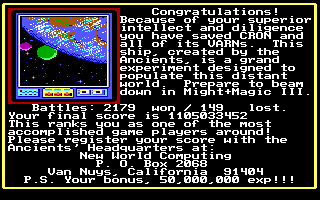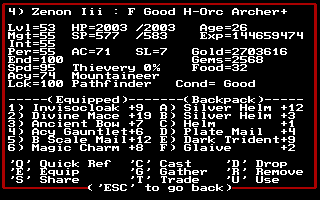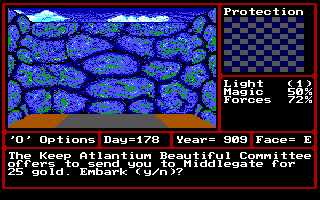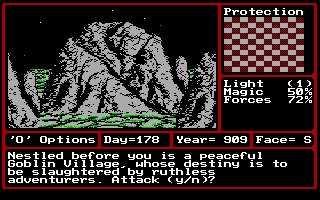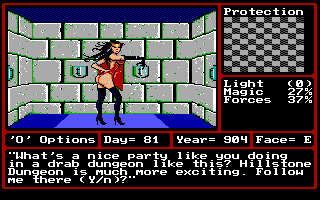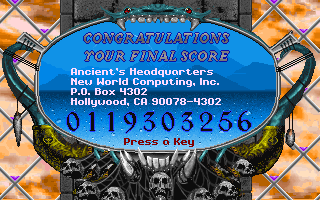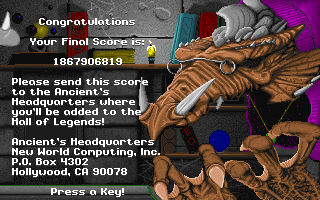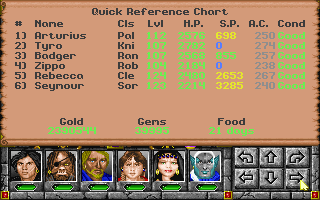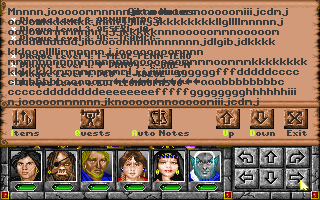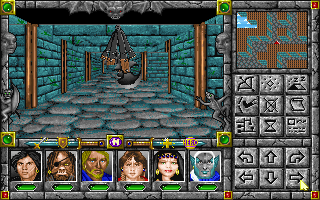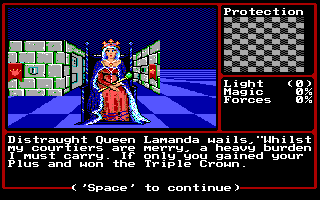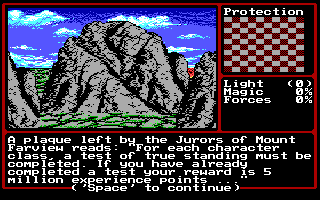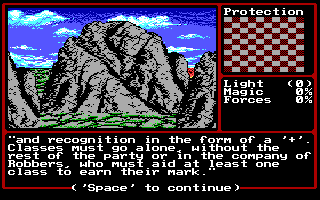So, I've finished the World of Xeen:
And to recap my impressions:
I: The things that both Darkside and Clouds shared:
1) Both had visual polish and a wonderous soundtrack oozing a sense of adventure. Almost every monster had its own distinct icon (even if it appeared once in the entire game - like the Dragon King in Clouds) and a silly posture it showed when it got hit. Almost every dungeon had some previously unseen graphical quirk or item. The intro to Clouds, along with its score, is a thing of beauty, and the ending cinematics (Crodo and Burlock watching the party whacking subsequent monsters) were very witty. Overall, I don't think I saw many games as good audiovisually as this one.
2) For the first time in the Might & Magic series, I was lacking resources at some point of the games; I was short of gems in the Clouds (until I hit the Castle Basenji and then the Northern Sphinx), and then I was unable to use my experience for level-ups in the late Darkside as I had practically no gold.
3) Seemingly, the primary purpose of combat is to pace the game rather than give the player any sort of challenge (unlike in the previous two titles, where the world was densely filled with encounters); given the simplistic nature of combat, it makes sense, even if it's not necessarily a good decision (I believe that, in general, the sluggishness of exploration can add up to the identity of a place - for better or worse).
4) The primitive character of some dungeons really ground my gears. All towers needed exactly four comically small levels before ascending into the clouds. Similarly, all castles looked pretty much the same, although there was always something interesting going on there, as six of seven of them were plot-related. The issue was exacerbated on the Darkside as each city had sewers (for what? They weren't even bad, but some of them felt forced). It doesn't seem like a big problem, but half of the dungeons were either towers or castles - and most of them were puzzle-free, contributing to their general blandness.
5) What I liked was individuating each city. They became fully fledged dungeons rather than hubs, with different sizes, utilities, and purposes. Also, with small cities becoming less cluttered (as there were no unnecessary buildings - like training / smith / temple) each city could contain (and did contain) some driving theme or quest - like ghosts in Winterkill, snake curse in Asp or the witches of Lakeside. Furthermore, those tended to be the best quests in the game.
6) Teleport spell felt needlessly handicapped. Almost always, when I wanted to use it, I was unable to. It's quite a decline, since it did add options and variability to exploration in the previous titles.
7) At last, I saw some locations devoid of combat (like Escape Pods, or higher levels of the Great Pyramid). I believe it was preferable to do them that way, as places without encounters can create a different atmosphere (especially with a proper score - like Escape Pods).
II: About Clouds of Xeen
1) The game is practically devoid of any puzzles. Even if there was anything to unravel (like passwords for Dwarven Mines or Castle Basenji), the answer was trivial to obtain (and oftentimes placed within auto-notes in a spoilery order). It removes one layer from the memorability of a dungeon (the others are structure, loot, and boosts in this case).
2) Side quests are bad. Pretty much each one of them (except for some city quests) boils down to finding some item / place or killing some monster. There was nothing as unpredictable or oddish as, say, Princess Trueberry's quest in Terra or Mark's keys in Gates. Rewards were mostly banal (except for spells - which were mostly useless and obtainable through guilds, if I'm not mistaken).
3) Dungeons did have distinctive features - like the watery Cave of Illusion that I could drain, Dragon Cave with, guess who, dragons (and also taxation), or Deep Mines with the bizarre teleport system and unpredictable structures.
4) The pacing of the early game felt botched: I rose to around 9th level very quickly (after Vertigo and some Deep Mines), until that time I barely encountered any traps, and by the time I saw them, I had all the spells allowing me to ignore them (like cure disease / poison, levitate, and, generalizing, Day of Sorcery+Protection).
5) It's the second game in the series where progression was built towards mostly lower level adventure (below 20). I felt it made the endgame way more concise than in some previous entries - subsequent levels made a visible difference while fighting with dragons or diamond golems.
III: About Darkside of Xeen
1) Puzzles did get better: the Drawkcab monks' quest, the Northern Tower goblet puzzle, or the chests in Castleview were all pretty entertaining (and I haven't seen them in any earlier entry). I don't think I ever saw before a puzzle, that can be brute-forced with a topological ordering of a graph (which is a case for chests in Castleview). What I didn't like were the criminally small rewards for solving any of them.
2) Solving side quests provided items not attainable in any other way, like entrances to cities or dungeons - which is a step up from before; nonetheless, most quests were just as uninspired as before.
3) I liked the idea of the Skyroad as an additional way of getting into places.
IV: The ending (add-on? everything after the showdown between Sheltem and Corak) is very bad and clearly unfinished:
1) Elemental planes are just as barren and futile as in the Gates to Another World.
2) It's the first time I encountered severe
in this series: the game was crashing if I scrolled low enough in Auto-notes, and the traps within the Southern Sphinx sometimes crashed the screen. Once I saw a Skeletal Lich, that couldn't get me as it was behind an invisible wall. To make matters worse, insect spray didn't work on them.
3) Almost all new monsters used the same icons as in the earlier games, and the new ones were not aesthetically spectacular, to put it bluntly. Some icons from Isles of Terra were re-used (for example, the throne and traps within the Southern Sphinx), rather than new ones - which is a surprise given the game's graphical polish and a disaster given the bugs they induced. There was no new part of the soundtrack.
4) Worst of all, the dungeons were almost universally uninspired or outright botched: the first floor of the Dungeon of Death was great, the third was passable, the Dragon Clouds were neat, and the rest was between bad and atrocious.
5) The only really interesting rewards at the end of the game could be stats, levels, and some resistances. Of course, almost all rewards (especially in the Dungeon of Death past the first floor) boiled down to experience (which was useless without huge amounts of money) and equipment (which was also pretty useless at that point).
In summary, it had no element that made (in my eyes) both Clouds and Darkside admirable, but it introduced a plethora of problems and bad content.
Overall, I think I preferred Isles of Terra to this one - World of Xeen improved upon the production values but was a downgrade in terms of puzzles, quests, and general exploration. Also, the game took a nosedive at the very end.






